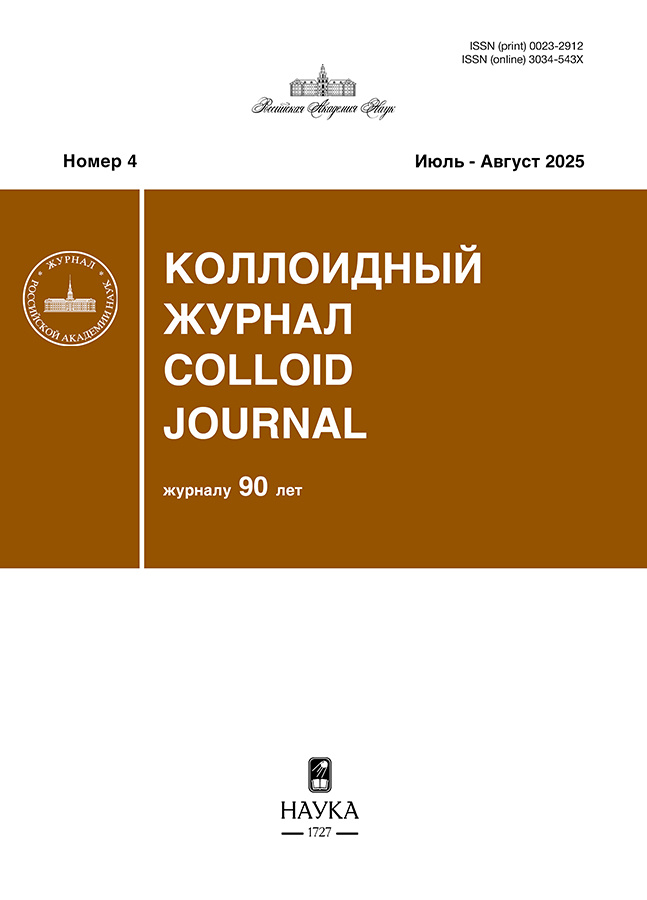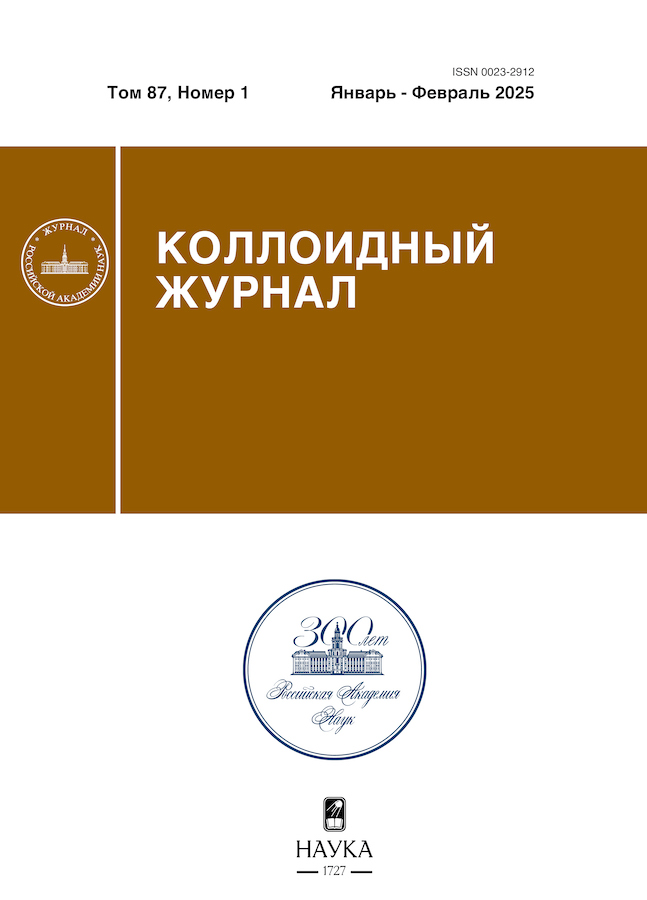Полимерные гели сферической формы, содержащие сульфонатные группы: синтез и адсорбционные свойства
- Авторы: Лаишевкина C.Г.1, Друян Л.М.1, Якобсон О.Д.1, Иванькова Е.М.1, Шабсельс Б.М.1, Шевченко Н.Н.1
-
Учреждения:
- Филиал федерального государственного бюджетного учреждения «Петербургский институт ядерной физики им. Б.П. Константинова Национального исследовательского центра «Курчатовский институт»
- Выпуск: Том 87, № 1 (2025)
- Страницы: 24-34
- Раздел: Статьи
- Статья получена: 28.05.2025
- Статья опубликована: 24.01.2025
- URL: https://transsyst.ru/0023-2912/article/view/680861
- DOI: https://doi.org/10.31857/S0023291225010031
- EDN: https://elibrary.ru/UTAPVR
- ID: 680861
Цитировать
Полный текст
Аннотация
Синтезированы пористые сшитые полиэлектролитные микросферы диаметром от 1 до 5 мкм либо с применением в качестве функционального мономера пара-стиролсульфоната, либо смеси сомономеров пара-стиролсульфоната и винилацетата. Содержание сульфонатных групп в полученных полиэлектролитных микросферах составляет более 2 ммоль/г. Показано, что введение гидрофобного сомономера существенно увеличивает степень набухания полиэлектролитных микросфер. Найдено, что величина адсорбции модельных соединений (фуксин, метиленовый синий) превышает концентрацию сульфонатных групп. Морфология, структура поверхностного слоя полиэлектролитных микросфер изучены методом оптической и растровой электронной микроскопии, ИК-спектроскопии, удельная поверхность определена методом БЭТ.
Ключевые слова
Полный текст
Об авторах
C. Г. Лаишевкина
Филиал федерального государственного бюджетного учреждения «Петербургский институт ядерной физики им. Б.П. Константинова Национального исследовательского центра «Курчатовский институт»
Email: natali.shevchenko29@gmail.com
Институт высокомолекулярных соединений
Россия, 199004, Санкт-Петербург, Большой пр. В.О., 31Л. М. Друян
Филиал федерального государственного бюджетного учреждения «Петербургский институт ядерной физики им. Б.П. Константинова Национального исследовательского центра «Курчатовский институт»
Email: natali.shevchenko29@gmail.com
Институт высокомолекулярных соединений
Россия, 199004, Санкт-Петербург, Большой пр. В.О., 31О. Д. Якобсон
Филиал федерального государственного бюджетного учреждения «Петербургский институт ядерной физики им. Б.П. Константинова Национального исследовательского центра «Курчатовский институт»
Email: natali.shevchenko29@gmail.com
Институт высокомолекулярных соединений
Россия, 199004, Санкт-Петербург, Большой пр. В.О., 31Е. М. Иванькова
Филиал федерального государственного бюджетного учреждения «Петербургский институт ядерной физики им. Б.П. Константинова Национального исследовательского центра «Курчатовский институт»
Email: natali.shevchenko29@gmail.com
Институт высокомолекулярных соединений
Россия, 199004, Санкт-Петербург, Большой пр. В.О., 31Б. М. Шабсельс
Филиал федерального государственного бюджетного учреждения «Петербургский институт ядерной физики им. Б.П. Константинова Национального исследовательского центра «Курчатовский институт»
Email: natali.shevchenko29@gmail.com
Институт высокомолекулярных соединений
Россия, 199004, Санкт-Петербург, Большой пр. В.О., 31Н. Н. Шевченко
Филиал федерального государственного бюджетного учреждения «Петербургский институт ядерной физики им. Б.П. Константинова Национального исследовательского центра «Курчатовский институт»
Автор, ответственный за переписку.
Email: natali.shevchenko29@gmail.com
Институт высокомолекулярных соединений
Россия, 199004, Санкт-Петербург, Большой пр. В.О., 31Список литературы
- Adepu S., Ramakrishna S. Controlled drug delivery systems: current status and future directions // Molecules. 2021. V. 26. № 19. P. 5905. https://doi.org/10.3390/molecules26195905
- Takenaga M., Serizawa Y., Azechi Y., Ochiai A., Kosaka Y., Igarashi R., Mizushima Y. Microparticle resins as a potential nasal drug delivery system for insulin // J. Control. Release. 1998. V. 52. № 1–2. P. 81–87. https://doi.org/10.1016/S0168-3659(97)00193-4
- Dong L., Zhang H., Zhang G., Li F., Li M., Wang H., Ye X., Ren X., Zhang J., Peng C., Liu H., Wu L. Polystyrene sulfonate resin as an ophthalmic carrier for enhanced bioavailability of ligustrazine phosphate controlled release system // J. Pharm Sci. 2024. V. 113. № 9. P. 2786–2794. https://doi.org/10.1016/j.xphs.2024.07.002
- Imazato S., Kitagawa H., Tsuboi R., Kitagawa R., Thongthai P., Sasaki J. Non-biodegradable polymer particles for drug delivery: A new technology for “bio-active” restorative materials // Dent. Mater. J. 2017. V. 36. № 5. P. 524–532. https://doi.org/10.4012/dmj.2017-156
- Kalenichenko D., Nifontova G., Karaulov A., Sukhanova A., Nabiev I. Designing functionalized polyelectrolyte microcapsules for cancer treatment // Nanomaterials. 2021. V. 11. № 11. P. 3055. https://doi.org/10.3390/nano11113055
- Кедик С.А., Суслов В.В., Шняк Е.А., Домнина Ю.М. Гелеобразующие полимеры для создания жидких эмболизатов // Разработка и регистрация лекарственных средств. 2017. V. 21. № 4. P. 56–63.
- Wang J., Li B., Qiu L., Qiao X., Yang H. Dendrimer-based drug delivery systems: history, challenges, and latest developments // J. Biol. Eng. 2022. V. 16. № 18. P. 18. https://doi.org/10.1186/s13036-022-00298-5
- de Lima C.S.A., Balogh T.S., Varca J.P.R.O., Varca .H.C., Lugão A.B., Camacho-Cruz L.A., Bucio E., Kadlubowski S.S. An updated review of macro, micro, and nanostructured hydrogels for biomedical and pharmaceutical applications // Pharmaceutics. 2020. V. 12. № 10. P. 970. https://doi.org/10.3390/pharmaceutics12100970
- Wechsler M.E., Stephenson R.E., Murphy A.C., Oldenkamp H.F., Singh A., Peppas N.A. Engineered microscale hydrogels for drug delivery, cell therapy, and sequencing // Biomed. Microdevices. 2019. V. 21. P. 31. https://doi.org/10.1007/s10544-019-0358-0
- Oh J.K., Drumright R., Siegwart D.J., Matyjaszewski K. The development of microgels/nanogels for drug delivery applications // Prog. Polym. Sci. 2008. V. 33. № 4. P. 448–477. https://doi.org/10.1016/j.progpolymsci.2008.01.002
- Stewart S.A., Domínguez-Robles J., Donnelly R.F., Larrañeta E. Implantable polymeric drug delivery devices: classification, manufacture, materials, and clinical applications // Polymers (Basel). 2018. V. 10. № 12. P. 1379. https://doi.org/10.3390/polym10121379
- Bettencourt A., Almeida A.J. Poly(methyl methacrylate) particulate carriers in drug delivery // J. Microencapsul. 2012. V. 29. № 4. P. 353–367. https://doi.org/10.3109/02652048.2011.651500
- Shaked E., Shani Y., Zilberman M., Scheinowitz M. Poly(methyl methacrylate) particles for local drug delivery using shock wave lithotripsy: In vitro proof of concept experiment // J. Biomed. Mater. Res. B Appl. Biomater. 2015. V. 103. № 6. P. 1228–1237. https://doi.org/10.1002/jbm.b.33301
- Schneider C., Langer R., Loveday D., Hair D. Applications of ethylene vinyl acetate copolymers (EVA) in drug delivery systems // J. Control. Release. 2017. V. 262. P. 284–295. https://doi.org/10.1016/j.jconrel.2017.08.004
- Rivera-Hernández G., Antunes-Ricardo M., Martínez-Morales P., Sánchez M. Polyvinyl alcohol based-drug delivery systems for cancer treatment // Int. J. Pharm. 2021. V. 600. P. 120478. https://doi.org/10.1016/j.ijpharm.2021.120478
- Lankalapalli S., Kolapalli V.R.M. Polyelectrolyte complexes: A review of their applicability in drug delivery technology // Indian J. Pharm. Sci. 2009. V. 71. № 5. P. 481–487. https://doi.org/10.4103/0250-474X.58165
- Лаишевкина C.Г., Якобсон О.Д., Иванькова Е.М., Шабсельс Б.М., Шевченко Н.Н. Влияние структуры сульфосодержащих полиэлектролитных матриц на адсорбцию ионов Cu2+ // Коллоидный журнал. 2024. Т. 86. № 1. С. 94–105. https://doi.org/10.31857/S0023291224010092
- Sudareva N., Suvorova O., Saprykina N., Vlasova H., Vilesov A. Doxorubicin delivery systems based on doped CaCO3 cores and polyanion drug conjugates // J. Microencapsul. 2021. V. 38. № 3. P. 164–176. https://doi.org/10.1080/02652048.2021.1872724
- Li F., Ye X., Li M., Nie Q., Wang H., Zhang G., Dong ., Wang C., Wu L., Liu H., Wang L., Peng C., Zhang J. Enhanced ophthalmic bioavailability and stability of atropine sulfate via sustained release particles using polystyrene sulfonate resin // Int. J. Pharm. 2024. V. 60. P. 124294. https://doi.org/10.1016/j.ijpharm.2024.124294
- Jahn P., Zelner M., Freger V., Ulbricht M. Polystyrene sulfonate particles as building blocks for nanofiltration membranes // Membranes (Basel). 2022. V. 12. № 11. P. 1138. https://doi.org/10.3390/membranes12111138
- Tiwari R., Walther A. Strong anionic polyelectrolyte microgels // Polym. Chem. 2015. V. 6. № 31. P. 5550–5554. https://doi.org/10.1039/c5py00426h
- Hofman A.H., Pedone M., Kamperman M. Protected poly(3-sulfopropyl methacrylate) copolymers: synthesis, stability, and orthogonal deprotection // ACS Polymers Au. 2022. V. 2. № 3. P. 169–180. https://doi.org/10.1021/acspolymersau.1c00044
- Fu Z., Liu M., Xu J., Wang Q., Fan Z. Stabilization of water-in-octane nano-emulsion. Part I: Stabilized by mixed surfactant systems // Fuel. 2010. V. 89. № 10. P. 2838–2843. https://doi.org/10.1016/j.fuel.2010.05.031
- Voronina N.S., Nechaev A.I., Strel’nikov V.N. Val’tsifer .A. Inverse Emulsion Copolymerization of acrylamide and 2-acrylamido-2-methylpropane sulfonic acid sodium salt for preparing water-soluble drag reduction additives // Russ. J. Appl. Chem. 2021. V. 4. P. 748–757. https://doi.org/10.1134/S1070427221060082
- Reddy B.V., Rao G.R. Vibrational spectra and modified valence force field for N,N’-methylenebisa-crylamide // Indian J. Pure Appl. Phys. 2008. V. 46. № 9. P. 611–616.
- Li C., He Y., Zhou L., Xu T., Hu J., Peng C., Liu H. Fast adsorption of methylene blue, basic fuchsin, and malachite green by a novel sulfonic-grafted triptycene-based porous organic polymer // RSC Adv. 2018. V. 8. № 73. P. 41986–41993. https://doi.org/10.1039/C8RA09012B
- Florence Ng., Naorem H. Dimerization of methylene blue in aqueous and mixed aqueous organic solvent: a spectroscopic study // J. Mol. Liq. 2014. V. 198. P. 255–258. https://doi.org/10.1016/j.molliq.2014.06.030
Дополнительные файлы



















